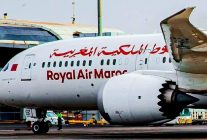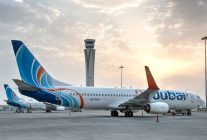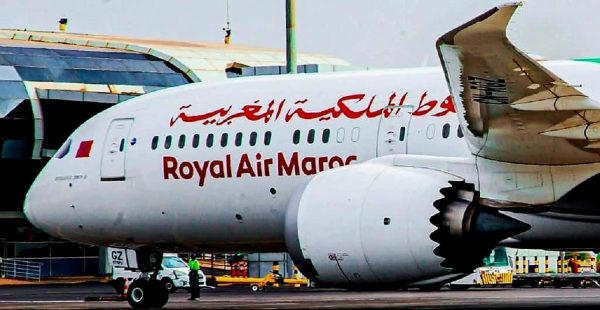Publié le 2 décembre 2025 à 09h00
Des offres Asiana Airlines sur Paris-Séoul
Publié le 16 mai 2014 à 12h00 par Marin Parigi

©Asiana Airlines
Vous avez apprécié l’article ?
Soutenez-nous, faites un don !
Commentaire(s)
Faire un don
Appel aux lecteurs !
Soutenez Air Journal participez à son développement !
Derniers commentaires
Le toulousain a commenté l'article :
EasyJet France : un préavis de grève des PNC fait peser une menace sur les vols de Noëlcrash UPS a commenté l'article :
Innovation technologique : un Boeing 767 transformé en bombardier d’eau de très grande capacité@serge13 a commenté l'article :
EasyJet France : un préavis de grève des PNC fait peser une menace sur les vols de NoëlLire aussi

Royal Air Maroc s’allie à Malaysia Airlines pour relier...

Les aéroports d’Asie-Pacifique et du Moyen-Orient s’attendent...

Korean Air et Asiana vont déployer Starlink à bord de leurs...
Abonnement
Publicité
masquée
Nos abonnés bénéficient d'une navigation fluide sans bandeaux publicitaires pour une meilleure lecture de nos contenus.
Pseudonyme
réservé
Votre pseudonyme est validé à partir de votre adresse mail, empêchant qu'un autre lecteur publie un commentaire à votre place.
Commentaire
instantané
Votre commentaire est publié instantanément. Les commentaires des non-abonnés ne sont publiés qu'après modération par notre équipe.
Articles les plus
consultés du mois
Publié le 4 décembre 2025 à 14h00 par Joël Ricci
Publié le 1 décembre 2025 à 12h00 par Joël Ricci
Publié le 7 décembre 2025 à 13h00 par Alain Hai
Publié le 1 décembre 2025 à 15h00 par Ricardo Moraes





cocolefou a commenté :
16 mai 2014 - 12 h 43 min
Compagnie de merde, ils ont sucé pour leurs 5* Skytrax, dangereuse (crah SFO juillet 13), retards, bouffe dégueu, 3x4x3 en éco…à fuir !
fufu06 a commenté :
16 mai 2014 - 13 h 51 min
très classe ce commentaire!!
Chopin14000 a commenté :
16 mai 2014 - 13 h 41 min
J’ai eu la chance de voyager en classe affaires sur Asiana et je peux vous dire que le niveau de service est bien plus élevé que celle d’AF. Quant à la sécurité je ne me suis pas senti plus en danger que dans une compagnie européenne.
Hclaudepie a commenté :
16 mai 2014 - 16 h 54 min
Pour l’accident de SFO, ça n’est pas à proprement parler la compagnie qui est en cause, mais dans l’attente des conclusions de l’enquête, il semblerait que ça soit une erreur humaine (trop lent, trop cabré, trop bas…)
Nom a commenté :
16 mai 2014 - 21 h 10 min
Erreur humaine en partie causer par le programme de qualification pilotes qui est completement biaise:
From a former UAL check captain.
After I retired from UAL as a Standards Captain on the –400, I got a job as a simulator instructor working for Alteon (a Boeing subsidiary) at Asiana. When I first got there, I was shocked and surprised by the lack of basic piloting skills shown by most of the pilots. It is not a normal situation with normal progression from new hire, right seat, left seat taking a decade or two. One big difference is that ex-Military pilots are given super-seniority and progress to the left seat much faster. Compared to the US, they also upgrade fairly rapidly because of the phenomenal growth by all Asian air carriers. By the way, after about six months at Asiana, I was moved over to KAL and found them to be identical. The only difference was the color of the uniforms and airplanes. I worked in Korea for 5 long years and although I found most of the people to be very pleasant, it’s a minefield of a work environment … for them and for us expats.
One of the first things I learned was that the pilots kept a web-site and reported on every training session. I don’t think this was officially sanctioned by the company, but after one or two simulator periods, a database was building on me (and everyone else) that told them exactly how I ran the sessions, what to expect on checks, and what to look out for. For example; I used to open an aft cargo door at 100 knots to get them to initiate an RTO and I would brief them on it during the briefing. This was on the B-737 NG and many of the captains were coming off the 777 or B744 and they were used to the Master Caution System being inhibited at 80 kts. Well, for the first few days after I started that, EVERYONE rejected the takeoff. Then, all of a sudden they all “got it” and continued the takeoff (in accordance with their manuals). The word had gotten out. I figured it was an overall PLUS for the training program.
We expat instructors were forced upon them after the amount of fatal accidents (most of the them totally avoidable) over a decade began to be noticed by the outside world. They were basically given an ultimatum by the FAA, Transport Canada, and the EU to totally rebuild and rethink their training program or face being banned from the skies all over the world. They hired Boeing and Airbus to staff the training centers. KAL has one center and Asiana has another. When I was there (2003-2008) we had about 60 expats conducting training KAL and about 40 at Asiana. Most instructors were from the USA, Canada, Australia, or New Zealand with a few stuffed in from Europe and Asia. Boeing also operated training centers in Singapore and China so they did hire some instructors from there.
This solution has only been partially successful but still faces ingrained resistance from the Koreans. I lost track of the number of highly qualified instructors I worked with who were fired because they tried to enforce “normal” standards of performance. By normal standards, I would include being able to master basic tasks like successfully shoot a visual approach with 10 kt crosswind and the weather CAVOK. I am not kidding when I tell you that requiring them to shoot a visual approach struck fear in their hearts … with good reason. Like this Asiana crew, it didnt’ compute that you needed to be a 1000’ AGL at 3 miles and your sink rate should be 600-800 Ft/Min. But, after 5 years, they finally nailed me. I still had to sign my name to their training and sometimes if I just couldn’t pass someone on a check, I had no choice but to fail them. I usually busted about 3-5 crews a year and the resistance against me built. I finally failed an extremely incompetent crew and it turned out he was the a high-ranking captain who was the Chief Line Check pilot on the fleet I was teaching on. I found out on my next monthly trip home that KAL was not going to renew my Visa. The crew I failed was given another check and continued a fly while talking about how unfair Captain Brown was.
Any of you Boeing glass-cockpit guys will know what I mean when I describe these events. I gave them a VOR approach with an 15 mile arc from the IAF. By the way, KAL dictated the profiles for all sessions and we just administered them. He requested two turns in holding at the IAF to get set up for the approach. When he finally got his nerve up, he requested “Radar Vectors” to final. He could have just said he was ready for the approach and I would have cleared him to the IAF and then “Cleared for the approach” and he could have selected “Exit Hold” and been on his way. He was already in LNAV/VNAV PATH. So, I gave him vectors to final with a 30 degree intercept. Of course, he failed to “Extend the FAF” and he couldn’t understand why it would not intercept the LNAV magenta line when he punched LNAV and VNAV. He made three approaches and missed approaches before he figured out that his active waypoint was “Hold at XYZ.” Every time he punched LNAV, it would try to go back to the IAF … just like it was supposed to do. Since it was a check, I was not allowed (by their own rules) to offer him any help. That was just one of about half dozen major errors I documented in his UNSAT paperwork. He also failed to put in ANY aileron on takeoff with a 30-knot direct crosswind (again, the weather was dictated by KAL).
This Asiana SFO accident makes me sick and while I am surprised there are not more, I expect that there will be many more of the same type accidents in the future unless some drastic steps are taken. They are already required to hire a certain percentage of expats to try to ingrain more flying expertise in them, but more likely, they will eventually be fired too. One of the best trainees I ever had was a Korean/American (he grew up and went to school in the USA) who flew C-141’s in the USAF. When he got out, he moved back to Korea and got hired by KAL. I met him when I gave him some training and a check on the B-737 and of course, he breezed through the training. I give him annual PCs for a few years and he was always a good pilot. Then, he got involved with trying to start a pilots union and when they tired to enforce some sort of duty rigs on international flights, he was fired after being arrested and JAILED!
The Koreans are very very bright and smart so I was puzzled by their inability to fly an airplane well. They would show up on Day 1 of training (an hour before the scheduled briefing time, in a 3-piece suit, and shined shoes) with the entire contents of the FCOM and Flight Manual totally memorized. But, putting that information to actual use was many times impossible. Crosswind landings are also an unsolvable puzzle for most of them. I never did figure it out completely, but I think I did uncover a few clues. Here is my best guess. First off, their educational system emphasizes ROTE memorization from the first day of school as little kids. As you know, that is the lowest form of learning and they act like robots. They are also taught to NEVER challenge authority and in spite of the flight training heavily emphasizing CRM/CLR, it still exists either on the surface or very subtly. You just can’t change 3000 years of culture.
The other thing that I think plays an important role is the fact that there is virtually NO civil aircraft flying in Korea. It’s actually illegal to own a Cessna-152 and just go learn to fly. Ultra-lights and Powered Hang Gliders are Ok. I guess they don’t trust the people to not start WW III by flying 35 miles north of Inchon into North Korea. But, they don’t get the kids who grew up flying (and thinking for themselves) and hanging around airports. They do recruit some kids from college and send then to the US or Australia and get them their tickets. Generally, I had better experience with them than with the ex-Military pilots. This was a surprise to me as I spent years as a Naval Aviator flying fighters after getting my private in light airplanes. I would get experienced F-4, F-5, F-15, and F-16 pilots who were actually terrible pilots if they had to hand fly the airplane. What a shock!
Finally, I’ll get off my box and talk about the total flight hours they claim. I do accept that there are a few talented and free-thinking pilots that I met and trained in Korea. Some are still in contact and I consider them friends. They were a joy! But, they were few and far between and certainly not the norm.
Actually, this is a worldwide problem involving automation and the auto-flight concept. Take one of these new first officers that got his ratings in the US or Australia and came to KAL or Asiana with 225 flight hours. After takeoff, in accordance with their SOP, he calls for the autopilot to be engaged at 250’ after takeoff. How much actual flight time is that? Hardly one minute. Then he might fly for hours on the autopilot and finally disengage it (MAYBE?) below 800’ after the gear was down, flaps extended and on airspeed (autothrottle). Then he might bring it in to land. Again, how much real “flight time” or real experience did he get. Minutes! Of course, on the 777 or 747, it’s the same only they get more inflated logbooks.
So, when I hear that a 10,000 hour Korean captain was vectored in for a 17-mile final and cleared for a visual approach in CAVOK weather, it raises the hair on the back of my neck.
Tom
voila voila
hclaudepie a commenté :
17 mai 2014 - 10 h 36 min
Voilà bien l’un des premiers commentaires, sages, nuancé, poli et surtout particulièrement informatif que je lis sur ce site. D’habitude, c’est plutôt l’invective.
Ça fait du bien ! Thanks Tom !
Flyer7 a commenté :
17 mai 2014 - 19 h 51 min
Le coté culturel de l’explication est très intéressant.
L’explication a été postée sur un forum? Y’a t’il des commentaires intéressant concernant ce qu’il dit?
Ce monsieur a t’il un retour d’expérience sur les compagnies japonaises? Ce qu’il décrit culturellement se retrouve aussi au Japon, je suis curieux de connaitre si cela s’applique aussi au monde l’aviation.
Mélissa A. a commenté :
16 mai 2014 - 16 h 58 min
Un des commentaires plus haut m’a l’air des plus neutres hein 😉
La nourriture servie est bien meilleure et abondante que sur AF, le personnel agréable et à l’écoute, la classe économique des plus correctes comparé aux prix…
AF aurait pas mal à apprendre d’eux (rien que pour l’amabilité) ~
Flop a commenté :
16 mai 2014 - 23 h 27 min
Pour avoir voyagé à plusieurs reprises en Business sur Asiana, je vous confirme que le service offert est excellent, ainsi que le produit proposé. Sans aucun doute, bien meilleur que l’actuel produit Business d’AF sur la même route… il faut dire que ce n’est pas difficile… on attend de voir leur nouveau “produit”, qui n’a semble-t-il strictement rien de révolutionnaire (un siège déjà largement utilisé par les concurrents et simplement “customisé” aux “couleurs” de la compagnie) et qui ne fait que le mettre à niveau de ses concurrents, sans plus… Et encore, car on est loin du produit Singapore Business… dommage pour une compagnie qui se targue de vouloir offrir, je cite: “le meilleur produit du marché”… je ne demande qu’à les croire, mais je suis plus que septique…
Groovy a commenté :
17 mai 2014 - 0 h 39 min
Olala dir que a fafhion tv on nous montre des manequins asiatik superbes et voila les boudins de asiax on se demande qui recrut pfff surement des boudins de la drh
sebastien1 a commenté :
17 mai 2014 - 3 h 54 min
Le post signé sans nom est de moi,par-contre il faut signaler le courage des pnc’s a bord du triple7 qui s’est crashé a San-Francisco,dont une qui malgré ses blessures a reussi a porter et evacuer plusieurs passagers